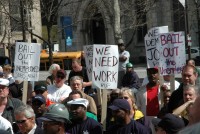 The U.S. economy is being slowly but surely destroyed and many Americans have no idea that it is happening. That is at least partially due to the fact that most financial news is entirely focused on the short-term. Whenever a key economic statistic goes up the financial markets surge and analysts rejoice. Whenever a key economic statistic goes down the financial markets decline and analysts speak of the potential for a “double-dip” recession. You could literally get whiplash as you watch the financial ping pong ball bounce back and forth between good news and bad news. But focusing on short-term statistics is not the correct way to analyze the U.S. economy. It is the long-term trends that reveal the truth. The reality is that there are certain underlying foundational problems that are destroying the U.S. economy a little bit more every single day.
The U.S. economy is being slowly but surely destroyed and many Americans have no idea that it is happening. That is at least partially due to the fact that most financial news is entirely focused on the short-term. Whenever a key economic statistic goes up the financial markets surge and analysts rejoice. Whenever a key economic statistic goes down the financial markets decline and analysts speak of the potential for a “double-dip” recession. You could literally get whiplash as you watch the financial ping pong ball bounce back and forth between good news and bad news. But focusing on short-term statistics is not the correct way to analyze the U.S. economy. It is the long-term trends that reveal the truth. The reality is that there are certain underlying foundational problems that are destroying the U.S. economy a little bit more every single day.
11 of those foundational problems are discussed below. They are undeniable and they are constantly getting worse. If they are not corrected (and there is no indication that they will be) they will destroy not only our economy but also our entire way of life. The sad truth is that it would be hard to understate just how desperate the situation is for the U.S. economy.
Long-Term Trend #1: The Deindustrialization Of America
The United States is being deindustrialized at a pace that is almost impossible to believe. But now that millions upon millions of people have lost their jobs, more Americans than ever are starting to wake up and believe it.
A recent NBC News/Wall Street Journal poll found that 69 percent of Americans now believe that free trade agreements have cost America jobs. Ten years ago the majority of Americans had great faith in the new “global economy” that we were all being merged into, but now the tide has turned.
So why have Americans lost faith in “free trade”?
Well, it turns out that the current system is neither “free trade” nor “fair trade”. Many other nations impose extremely high tariffs on U.S. goods and put up ridiculous barriers to American products and yet the United States has generally let everyone else openly manipulate currency rates and flood our shores with whatever cheap products they want.
The results have been disastrous. Jobs and factories have been leaving the United States at a blinding pace.
The United States has lost approximately 42,400 factories since 2001. An economy without a manufacturing base does not have a bright long-term future. Yet our politicians have allowed our manufacturing base to be systematically dismantled.
As of the end of 2009, less than 12 million Americans worked in manufacturing. The last time that less than 12 million Americans were employed in manufacturing was in 1941.
How is the United States supposed to have a bright economic future if it consumes everything in sight and yet makes very little?
Something needs to be done.
In 1959, manufacturing represented 28 percent of all U.S. economic output. In 2008, it represented only 11.5 percent and it continues to fall.
Needless to say, millions of blue collar workers now find themselves unable to find jobs. Today, 28% of all U.S. households have at least one person that is looking for a full-time job and there is no sign that things are going to improve much any time soon.
Long-Term Trend #2: The Exploding U.S. Trade Deficit
Each month, tens of billions more dollars go out of the United States than come into it. In other words, every single month the United States gets poorer.
Recently, the U.S. trade deficit has been coming in at around 40 to 50 billion dollars a month. About half of that is with communist China.
Between 2000 and 2009, America’s trade deficit with China increased nearly 300 percent.
Sadly, things are getting even worse.
As of the end of July, the U.S. trade deficit with China had risen 18 percent compared to the same time period a year ago.
There is a reason why China has been able to loan the U.S. government nearly a trillion dollars. They have literally been bleeding us dry.
The United States spends approximately $3.90 on Chinese goods for every $1 that the Chinese spend on goods from the United States.
Does that sound like “fair trade” to you?
According to a new study conducted by the Economic Policy Institute, if the U.S. trade deficit with China continues to increase at its current rate, the U.S. economy will lose over half a million jobs this year alone.
Half a million jobs in just one year?
And that doesn’t even take into account the trade deficit that we have with all the other nations around the world.
We have literally built China into a superpower.
One prominent economist is now projecting that the Chinese economy will be three times larger than the U.S. economy by the year 2040.
But it isn’t just China that is a problem.
Since the implementation of NAFTA in 1994, 300,000 U.S. farms have gone out of business.
Globalism has forced U.S. workers to directly compete with the cheapest labor in the world for jobs. That is not good for American workers and it is not good for America.
Long-Term Trend #3: The Shrinking Middle Class
As jobs continue to flee the United States and as wages continue to be depressed, America’s middle class is shrinking at an alarming rate.
According to a poll taken in 2009, 61 percent of Americans “always or usually” live paycheck to paycheck. That was up substantially from 49 percent in 2008 and 43 percent in 2007.
Unfortunately, a growing number of Americans have found it impossible to make it from month to month without direct financial assistance from the federal government.
41 million Americans are now on food stamps. One out of every six Americans is now enrolled in at least one anti-poverty program run by the federal government. Economic pain is everywhere.
Tens of millions of Americans now live in poverty. The U.S. Census Bureau says that 43.6 million Americans are now living in poverty and according to them that is the highest number of poor Americans that they have ever recorded in 51 years of record-keeping.
Long-Term Trend #4: The Growing Size Of The U.S. Government
No matter whether it is a Republican or a Democrat in the White House, the size of the U.S. government has continued to grow by leaps and bounds in recent years.
This is a tremendous drain on the U.S. economy. The government produces very little value for the economy and yet costs a colossal amount to maintain.
In addition, multiplying government regulations have caused the United States to be a very difficult environment to operate a business in.
The Federal Register is the main source of regulations for U.S. government agencies. In 1936, the number of pages in the Federal Register was about 2,600. Today, the Federal Register is over 80,000 pages long.
Long-Term Trend #5: The Constantly Growing U.S. National Debt
The United States has accumulated the biggest mountain of debt in the history of the world and every single month it gets worse.
According to an official U.S. Treasury Department report to Congress, the U.S. national debt will top $13.6 trillion this year and will climb to an estimated $19.6 trillion by 2015.
Do we really want to pass on a 20 trillion dollar debt to our children and grandchildren?
But the truth is that the situation is actually a lot worse than that.
If the U.S. government was forced to use GAAP accounting principles (like all publicly-traded corporations must), the U.S. government budget deficit would be somewhere in the neighborhood of $4 trillion to $5 trillion each and every year.
Needless to say, that is not anywhere close to sustainable. We are literally destroying our economic future with all of this debt.
Long-Term Trend #6: The Ongoing Devaluation Of The U.S. Dollar
The Federal Reserve constantly destroys the value of the U.S. dollar. Since the Federal Reserve was created in 1913, the U.S. dollar has lost over 95 percent of its purchasing power.
An item that cost $20.00 in 1970 would cost you $112.35 today. An item that cost $20.00 in 1913 would cost you $440.33 today.
Inflation is like a hidden tax. The value of the dollars you are holding right now will decline a little bit more each and every month.
And now that the Federal Reserve is threatening to unleash another round of quantitative easing, it appears that the value of our dollars will soon be declining even more rapidly.
Long-Term Trend #7: The Derivatives Bubble
The one thing that the “Wall Street reform bill” should have done was that it should have done something about the horrific abuses in the derivatives markets. Instead, the Wall Street reform bill did next to nothing about derivatives and instead imposed hundreds of other useless regulations on Wall Street.
Most Americans don’t even know what derivatives are. Basically, they are side bets. They have no underlying value of their own. But today derivatives have taken center stage on Wall Street. Our financial markets have become a gigantic casino.
The total value of all derivatives worldwide is estimated to be somewhere between 600 trillion and 1.5 quadrillion dollars. And thanks to the U.S. Congress, the derivatives bubble is still growing.
It would be hard to understate the danger that the derivatives bubble represents. The danger from derivatives is so great that Warren Buffet once called them “financial weapons of mass destruction”.
When the derivatives bubble finally pops, there will not be enough money in the entire world to fix it.
Long-Term Trend #8: The Health Care Industry
The United States health care system is completely and totally broken. It has become a gigantic money making machine for health insurance companies, pharmaceutical corporations and greedy lawyers.
Americans pay more for health care than anyone else in the world and yet they get shockingly little in return.
Health care expenses are the number one reason why people file for personal bankrupty in the United States. Surprisingly, most of those who get bankrupted by health care expenses actually have health insurance.
The health insurance system in the United States is a complete and total mess. Health insurance premiums are busting the budgets of tens of millions of American families and yet they are getting ready to go up yet once again.
Already, large numbers of health insurance companies across the United States have announced that they plan to increase health insurance premiums in response to the new health care law.
But do health insurance companies actually need more money? Even as the rest of the U.S. economy deeply struggles, America’s health insurance companies increased their profits by 56 percent in 2009.
At least someone is doing well in this economy.
The truth is that the U.S. health care system needs to be totally and completely reinvented. The system we had before did not work. Barack Obama’s new health care system will be far worse. Meanwhile, the health care industry is literally choking the life out of the U.S. economy.
Long-Term Trend #9: Financial Power Is Becoming Concentrated In Fewer And Fewer Hands
Once upon a time, the United States had a very diverse financial system. But today financial power is becoming concentrated in fewer and fewer hands with each passing year.
More U.S. banks fail every single week. In fact, the number of bank failures is on pace to far surpass the total of 140 U.S. banks that failed last year.
There are now nearly 900 banks (well over 10 percent of all U.S. banks) on the FDIC list of problem banks.
Meanwhile, the “too big to fail” banks continue to pick up market share. The “big four” U.S. banks (Citigroup, JPMorgan Chase, Bank of America and Wells Fargo) had approximately 22 percent of all deposits in FDIC-insured institutions back in 2000. As of June 30th of last year that figure was up to 39 percent.
Putting an increasing amount of financial power into the hands of just a few elite banks is a recipe for disaster any way you want to cut it.
Long-Term Trend #10: Rampant Corruption On Wall Street
Our financial system has become an absolute cesspool of corruption. In the past I have written extensively about all of the corruption that Goldman Sachs has been involved in, but they are far from alone.
In fact, it seems like new stories of financial corruption emerge almost daily now.
For example, just recently Bank of America, JPMorgan Chase and GMAC Mortgage have all suspended foreclosures in many U.S. states due to serious concerns about foreclosure procedures.
But there is a lot of corruption that is a lot worse than that. The rampant manipulation of the gold and silver markets was completely blown open by an industry insider earlier this year, but the U.S. government had to be publicly shamed before they would even agree to look into it.
The truth is that corruption on Wall Street has become so common that it is almost impossible to keep up with it all. It seems like no matter what stone you turn over on Wall Street these days you find yet more corruption.
But if the core of our financial system is so incredibly corrupt, how long will it be before it collapses in on itself?
Long-Term Trend #11: The Growing Retirement Crisis That Threatens To Bankrupt America
The Baby Boomers may end up bankrupting America after all. A retirement tsunami is coming that threatens to drown our nation in a sea of red ink.
The truth is that Americans have not been preparing for retirement on their own. One shocking new study indicates that Americans are $6.6 trillion short of what they need to retire comfortably.
In fact, approximately half of all workers in the United States have less than $2000 saved up for retirement.
So what about corporate pension plans?
Are they in good shape?
No.
One recent study found that America’s 100 largest corporate pension plans were underfunded by $217 billion as of the end of 2008.
But sadly, the pension plans run by U.S. state governments are in even worse shape.
Robert Novy-Marx of the University of Chicago and Joshua D. Rauh of Northwestern’s Kellogg School of Management recently calculated the combined pension liability of all 50 U.S. states. What they found was that the 50 states are collectively facing $5.17 trillion in pension obligations, but they only have $1.94 trillion set aside in state pension funds. That means that collectively, the 50 U.S. state governments are 3.2 trillion dollars short of what they need to meet their pension obligations.
But the biggest mess of all may be the U.S. Social Security system.
The sad reality is that anyone that has studied it closely knows that it is nothing more than a Ponzi scheme, and the scam has just about run its course.
According to the Congressional Budget Office, the Social Security system will pay out more in benefits than it receives in payroll taxes in 2010. That was not supposed to happen until at least 2016.
Oops.
But things get really hairy when you start looking down the road.
The present value of projected scheduled benefits surpasses earmarked revenues for entitlement programs such as Social Security and Medicare by about 46 trillion dollars over the next 75 years.
Ouch.
It is time to face facts people.
We are in deep, deep, deep trouble.
An increasing number of Americans are starting to realize this. They may not always know the specifics of what is going wrong, but more people than ever realize that something is broken. According to one recent survey, 63 percent of Americans believe that the United States is on the wrong track.
And we are very much on the wrong track. We have squandered the great wealth that our parents and grandparents left us and we are wrecking the greatest economic machine that the world has ever seen.
If we do not get our act together, someday people will look back and will curse this generation for how incredibly stupid we were.
 Does anyone really want to hear that America is in decline? For decades, most of us have been raised to believe that the United States is “number one” and that anyone who doubts that fact is a “gloom and doomer” that should just pack up and move to “Russia” or “Iraq” or some other country where things are not nearly as good. But does it do us or future generations any good to ignore the very serious signs of trouble that are erupting all around us? The truth is that it is about time to wake up and admit how much trouble we are actually in. The U.S. government is absolutely drowning in debt. The entire society is absolutely drowning in debt. We are being slaughtered in the arena of world trade, and every single month tens of billions of dollars (along with large numbers of factories and jobs) leave our shores for good. Our infrastructure is failing, our kids are less educated and our incomes are going down. We have serious, serious problems. At one time, the U.S. economy was so dominant that it was not even worth talking about who was in second place. That is no longer the case in 2010. Our forefathers handed us the greatest economic machine in history and we have allowed it to fall apart right in front of our eyes. A national economic crisis of historic proportions is getting worse with each passing month, and yet most of our leaders seem to be asleep at the switch.
Does anyone really want to hear that America is in decline? For decades, most of us have been raised to believe that the United States is “number one” and that anyone who doubts that fact is a “gloom and doomer” that should just pack up and move to “Russia” or “Iraq” or some other country where things are not nearly as good. But does it do us or future generations any good to ignore the very serious signs of trouble that are erupting all around us? The truth is that it is about time to wake up and admit how much trouble we are actually in. The U.S. government is absolutely drowning in debt. The entire society is absolutely drowning in debt. We are being slaughtered in the arena of world trade, and every single month tens of billions of dollars (along with large numbers of factories and jobs) leave our shores for good. Our infrastructure is failing, our kids are less educated and our incomes are going down. We have serious, serious problems. At one time, the U.S. economy was so dominant that it was not even worth talking about who was in second place. That is no longer the case in 2010. Our forefathers handed us the greatest economic machine in history and we have allowed it to fall apart right in front of our eyes. A national economic crisis of historic proportions is getting worse with each passing month, and yet most of our leaders seem to be asleep at the switch. 







